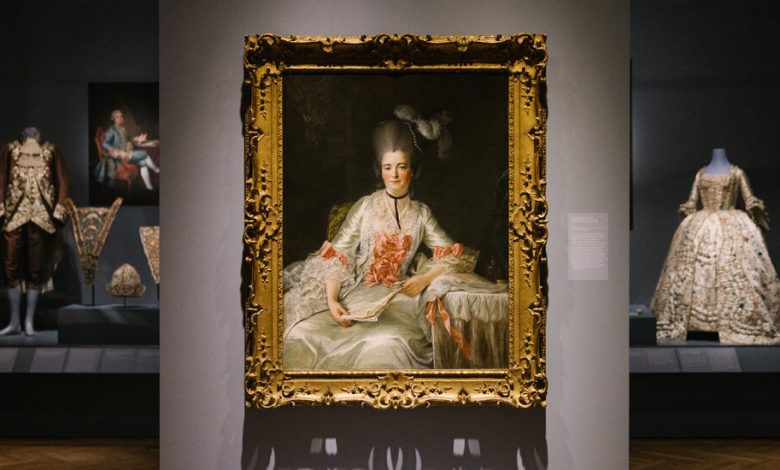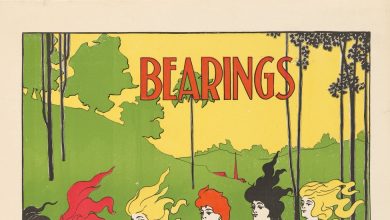Lace, That Most Coveted Textile

You never know what you don’t know, until, suddenly, you do. Who doesn’t love Vermeer’s 1669-70 painting, “The Lacemaker,” with its soft light and aura of beatific, if not virginal concentration? But who knows, exactly, what the young woman it depicts is up to?
Her intricately coiffured head bends over a small pillow; we see her hands holding some small pieces of wood, but not her handiwork. Mostly we know, as Vermeer probably intended, that her attention to the task before her mirrors ours to the mysterious painting she inhabits.
Her work is revealed early in “Threads of Power: Lace From the Textilmuseum St. Gallen,” an enticing exhibition at the Bard Graduate Center. This show explores European lace which, like all lace, is a textile that involves no weaving and has openwork structure. In the galleries and its exemplary catalog, “Threads of Power” examines this textile’s development and technologies, its economic inequities and its role as status symbol among secular and ecclesiastical elites, as well as its seductive beauty. Accompanied by portraits of lace-wearing notables, it ranges from the early 1600s forward, starting with samplers, borders and collars, through the opulence of Spanish and French court dress to a phalanx of 21st-century haute couture. This last is led by the ensemble in yellow felted wool lace, designed by Isabel Toledo and worn by Michelle Obama to the 2009 presidential inauguration.

Evening dresses including those by Yves Saint Laurent, Hubert de Givenchy, Marc Bohan, and Isabel Toledo’s inaugural ensemble for First Lady Michelle Obama in lemongrass felted wool lace.Credit…Da Ping Luo
The show virtually begins with a large color reproduction of Vermeer’s craftswoman near a real late-19th-century “lacemaking pillow” with a piece of lace in progress and a video of it in use. You get to peek over the lacemaker’s shoulder: She is making bobbin lace, one of the most expensive commodities of early modern Europe.
Descended from braiding, which was used to make trim for garments, bobbin lace required the use of numerous linen threads, each attached at both ends to a wood bobbin (this one has about 28) following a design on vellum. On the video, a woman’s hands move nimbly, picking up rods, crossing, twisting or knotting their threads, putting them down and picking up others. It is dizzying to watch.
The second foundational technique of lacemaking is also introduced: needle lace, descended from embroidery and requiring only a single thread and one needle. Building on these methods, their many variations and sometimes combinations, this exhibition provides a brief history of European lace.
The 150 examples of lace that form the core of the show come from the collection of the Textilmuseum St. Gallen, founded in 1878 by Leopold Iklé, a St. Gallen-based textile manufacturer (1838-1922). All its inclusions were selected by Emma Cormack, associate curator, and Michele Majer, professor emerita, textile and fashion history, at the Bard Graduate Center, and Ilona Kos, curator at the St. Gallen museum. Cormack and Majer have also edited an extraordinary catalog/history, plainly written yet specialized. I suggest working into the texts via the glossary.
In the beginning lace was made by aristocratic women for themselves — Vermeer’s well-dressed lady may have been one. But demand expanded and it was soon a cottage industry, produced by highly skilled, poorly paid women who, unlike many male laborers, did not have the protection of a guild against, say, damaged eyesight. By the mid-19th-century machines and chemical processes had largely taken over.
During the 1600s, lacemaking spread rapidly across Europe from country to country and city to city. By chance, you can get a sense of its arrival in England in the Metropolitan Museum of Art’s extravagant exhibition: “The Tudors: Art and Majesty in Renaissance England.” Henry VIII’s portraits from the first half of the century? Not much lace. Those of his daughter, Elizabeth I? Lots. The most prominent were the wide undulating ruff or millstone lace collars that she helped popularize, but also wide butterfly collars spreading up behind her like a lizard’s frill. Over the course of the first gallery lace frees itself from geometric patterns echoing the grid of textiles, and embraces more robust, less predictable, curvilinear patterns inspired by floral and plant forms. These motifs became more available with the appearance of printed books of botanical studies, or herbals, three of which —- from 1556, 1598 and 1625 — are displayed here. Especially notable are two chalice palls — or covers — about 7 inches square whose plant motifs are very bold in scale.
The exhibition then follows lace into higher realms of church, state and fashion, diversification and excess. A gold needle-lace panel 12 feet across (possibly an altar frontal) has tiny religious scenes encroached upon by nature-based patterns as if by jungle growth. The lace becomes more complicated and refined as demonstrated by a glove, rabats (men’s collars) and mantelets (short shawls to cover a woman’s shoulders). A piece of a wide late-17th-century French border turns to architecture for inspiration, specifically the half-domed niches of a lavish room, which it converts into an astounding filigree. But sometimes no motif is evident, as in a collar where the lace pattern is tiny, and goes every which way, as if the pattern were based on the scribbles of very small adept child.
In a gallery that suggests a pre-revolutionary French sitting room, we are greeted by a portrait of Marie Rinteau, the great-grandmother of George Sand, seated at her dressing table, as painted by François Hubert Drouais in 1761; her forearms emerge from beribboned froths of lace and a separate lace collar slightly obscures her décolletage. Her luxurious array is echoed by three life-size mannequins — two female and one male — seeming attired for appearances at the royal court. Also here are a lace stomacher, lace sleeping caps and lots of lappets, the long, narrow strips of lace attached in pairs to a woman’s hair or headdress that were de rigueur at some European courts.
Toward the end, the show races from the 19th to the 21st centuries, starting with the especially delicate Chantilly lace — a bobbin-lace made of very fine silk thread — that originated in the French town of the same name. It was very popular, glamorous, especially in black, as evidenced here by a majestic triangular shawl and the trim that fires up a yellow silk taffeta ball gown from France in the late 1850s.
In the final gallery await gowns, cocktail dresses and suits all incorporating impressive amounts of lace — by Dior, Yves Saint Laurent, Prada, Marc Bohan. After Mrs. Obama’s, the strongest impression is made by a white pantsuit by Akris Ready-to-Wear from 2018. It reduces lace to its origin, an open grid, something like a wearable Sol LeWitt.
This exhibition invites you to contemplate the beauty and ingeniousness of lace, and the extreme skill in creating it, but also the undervaluing of labor and the superfluous use of surplus income that seems essential to the rise and fall of any civilization.
Threads of Power: Lace From the Textilmuseum St. Gallen
Through Jan. 1 at the Bard Graduate Center, 18 West 86th Street, 212-501-3023, bgc.bard.edu.





